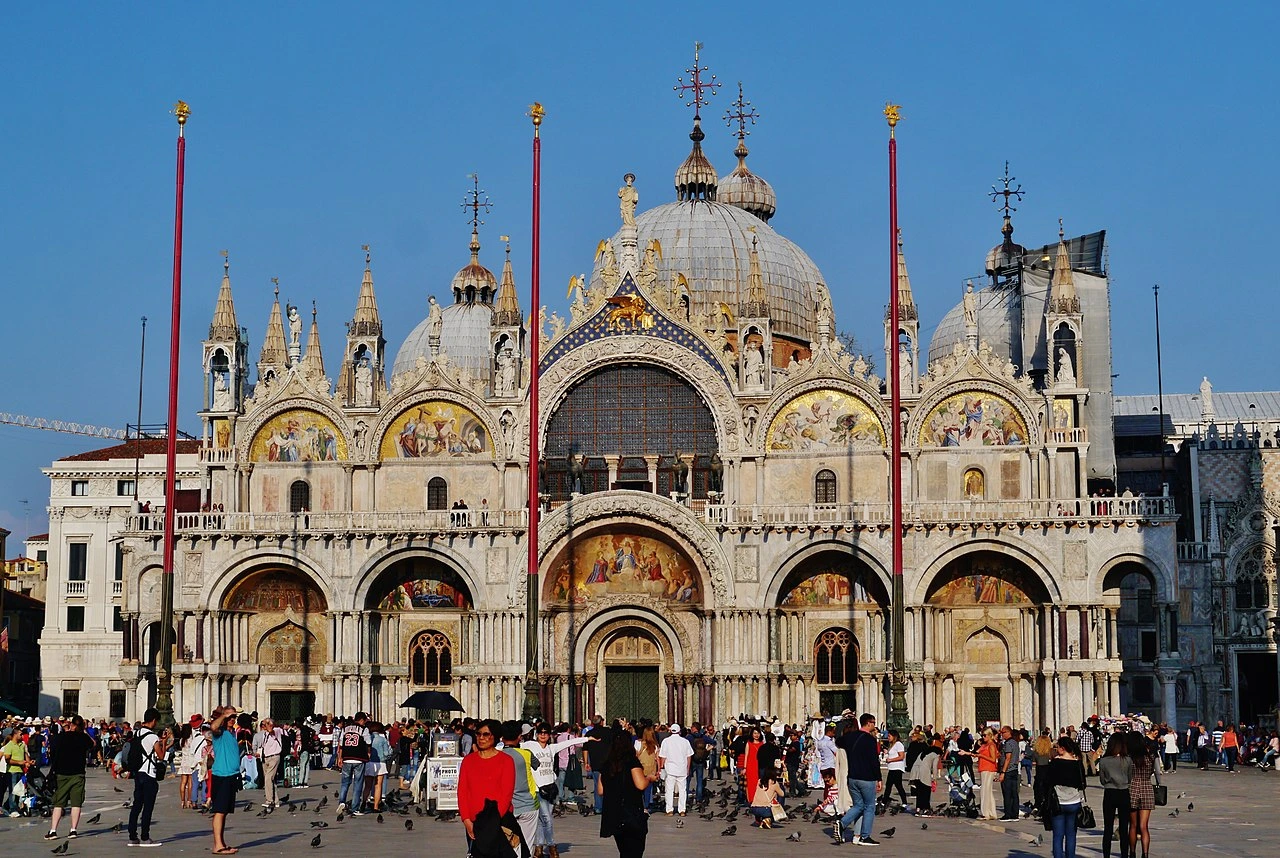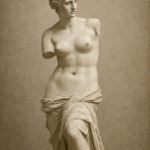
St. Mark’s Basilica isn’t just a church—it’s a dazzling mosaic of history, architecture, and legend nestled in the heart of Venice. With its golden domes, Byzantine splendor, and centuries-old relics, this iconic cathedral has captivated travelers, historians, and art lovers for over a millennium. From its origins as a private chapel for Venetian doges to its transformation into a cathedral filled with over 8,000 square meters of shimmering mosaics, every corner of the basilica tells a story. Whether you’re planning a visit or simply curious about its secrets, this blog dives deep into 25 fascinating facts that reveal the grandeur, mystery, and enduring legacy of one of the world’s most remarkable religious monuments. Let’s explore the numbers, dates, and records that make St. Mark’s Basilica a true marvel of human achievement.
1. The Arrival of St. Mark’s Relics in 828 AD
In the year 828 AD, two Venetian merchants, Buono da Malamocco and Rustico da Torcello, undertook a daring mission to retrieve the relics of St. Mark the Evangelist from Alexandria, Egypt. According to medieval chronicles, they concealed the saint’s remains beneath pork to avoid detection by Muslim customs officials, who would not touch the meat. This event was pivotal in Venetian history, as it marked the beginning of Venice’s spiritual and political alignment with St. Mark, replacing St. Theodore as the city’s patron saint. The relics were initially housed in a corner tower of the Doge’s fortified palace, symbolizing the fusion of religious reverence and state power. This act of relic acquisition was not only a religious gesture but also a political statement, asserting Venice’s growing independence and influence in the Mediterranean world.
2. Construction of the First Church in 832 AD
Following the arrival of St. Mark’s relics, the first church dedicated to him was completed by 832 AD under the direction of Doge Giovanni I Participazio, fulfilling the will of his brother, Doge Giustiniano Participazio. This early structure was built between the Doge’s palace and the Church of St. Theodore, symbolizing the transition of Venice’s spiritual allegiance. Although long believed to be rectangular, archaeological excavations revealed that the church was cruciform in layout, featuring a central dome—likely made of wood—reflecting Byzantine architectural influence. This design choice was a radical departure from local traditions and underscored Venice’s growing ties with Constantinople. The church served not only as a religious sanctuary but also as a state chapel, reinforcing the intertwining of civic pride and ecclesiastical authority.
3. Destruction by Fire in 976 AD
In 976 AD, the original basilica suffered extensive damage during a violent uprising against Doge Pietro IV Candiano. The revolt, sparked by political unrest, led to the burning of the Doge’s palace, and the flames spread to the adjacent church. Although the structure was not entirely destroyed, the damage was severe enough that the general assembly had to convene elsewhere to elect a new Doge. The wooden components of the church were likely consumed by the fire, while the brick walls and foundational supports remained intact. The rebuilding effort was spearheaded by Doge Pietro I Orseolo, who financed the repairs through his family’s resources. This event marked a turning point in the basilica’s history, as it set the stage for future architectural transformations and reinforced the resilience of Venice’s religious and political institutions.
4. Construction of the Present Basilica (1063–1094 AD)
The current structure of St. Mark’s Basilica was initiated around 1063 AD under Doge Domenico I Contarini and consecrated on 8 October 1094 by Doge Vitale Falier. This ambitious project reflected Venice’s desire to showcase its wealth, power, and cultural sophistication. The basilica was modeled after the Church of the Holy Apostles in Constantinople, featuring a Greek cross plan and five domes. The wooden domes of earlier versions were replaced with brick barrel vaults, requiring reinforced walls and piers. The high altar was relocated to the chancel, which was elevated and supported by a network of columns and vaults. The interior was adorned with mosaics, many created by artisans from Constantinople, and the Pala d’Oro, a golden altarpiece ordered in 1102, was installed in 1105. This phase of construction marked the transformation of the basilica into a monumental symbol of Venice’s imperial aspirations and spiritual devotion.
5. Cathedral Designation in 1807 AD
Although St. Mark’s Basilica had served as the Doge’s private chapel for centuries, it was not officially designated as Venice’s cathedral until 1807 AD. This change occurred under the influence of Napoleon Bonaparte, who had conquered Venice a decade earlier in 1797, ending the Republic’s long-standing independence. The basilica replaced San Pietro di Castello as the episcopal seat of the Patriarchate of Venice, signifying a shift in its religious status from a state sanctuary to the central church of the city’s Catholic hierarchy. This transition reflected broader political and ecclesiastical reforms imposed during the Napoleonic era and marked the beginning of a new chapter in the basilica’s history, one that emphasized its role in the spiritual life of Venice rather than its function as a symbol of republican power.
6. Collapse and Reconstruction of the Campanile (1902–1912)
On July 14, 1902, the Campanile of St. Mark’s Basilica, one of Venice’s most iconic landmarks, unexpectedly collapsed. Standing at 98.6 meters (323 feet), the bell tower had shown signs of structural weakness, but the sudden failure shocked the city. Miraculously, no one was killed except for the caretaker’s cat. The collapse destroyed the loggetta at its base and damaged nearby buildings, but the basilica itself was spared. In response, the Venetian government decided to rebuild the tower “com’era, dov’era” (“as it was, where it was”), a phrase that became symbolic of heritage preservation. Reconstruction began in 1903 and was completed by 1912, using reinforced concrete and modern engineering techniques to ensure stability while preserving the original appearance. The new Campanile retained its historical proportions and design, including the pyramidal spire and golden statue of the Archangel Gabriel at the top.
7. Over 8,000 Square Meters of Gold Mosaics
St. Mark’s Basilica is renowned for its extensive mosaic decoration, which covers over 8,000 square meters of its interior surfaces. These mosaics, created over several centuries from the 11th to the 19th century, depict biblical scenes, saints, and symbolic motifs in shimmering gold, glass, and colored stone. The gold tesserae were made by sandwiching gold leaf between layers of glass, a technique perfected by Byzantine artisans. The mosaics serve not only as religious storytelling devices but also as visual expressions of Venice’s wealth and its close ties to the Eastern Roman Empire. The sheer scale of the mosaic program makes it one of the largest and most opulent in the Christian world. Restoration efforts continue to preserve these fragile artworks, which are vulnerable to humidity, salt air, and flooding.
8. Central Dome Mosaics Depict Creation and Pentecost
The central dome of St. Mark’s Basilica is a masterpiece of religious art, featuring mosaics that depict the Creation of the World and the Pentecost. These mosaics date from the 11th to 13th centuries and reflect a blend of Byzantine iconography and Western stylistic influences. The Creation scenes include vivid representations of Adam and Eve, the Garden of Eden, and the separation of light from darkness, while the Pentecost imagery shows the descent of the Holy Spirit upon the Apostles. The dome’s height of approximately 43 meters allows for dramatic visual impact, with the gold background enhancing the sense of divine illumination. The theological themes emphasize the basilica’s role as a sacred space where heaven and earth converge, and the dome itself acts as a symbolic vault of the heavens.
9. Uneven Opus Sectile Marble Floors
The basilica’s floors are crafted in opus sectile, a technique involving the inlay of colored marble and stone to create intricate geometric and figurative designs. Over the centuries, the marble floors have become uneven, a result of Venice’s unstable foundations, periodic flooding, and natural subsidence. The floors feature patterns ranging from interlocking circles to animal motifs, reflecting both Eastern and Western artistic traditions. Some sections date back to the 11th century, while others were added or restored in later periods. The unevenness is not merely aesthetic—it poses challenges for conservation and accessibility. Preservation efforts include careful documentation, stabilization of the substructure, and protective measures against water damage, especially during acqua alta events.
10. Greek Cross Plan and Byzantine Architecture
St. Mark’s Basilica is designed in the form of a Greek cross, with four arms of equal length intersecting beneath a central dome. This architectural layout is characteristic of Byzantine churches, particularly those in Constantinople, such as the Church of the Holy Apostles. The basilica’s five domes—one central and four over each arm—are supported by massive piers and arches, allowing for a spacious and symmetrical interior. The use of domes, mosaics, and marble revetments reflects Venice’s desire to emulate the grandeur of the Eastern Roman Empire. The Greek cross plan also facilitates liturgical movement and visual focus on the altar, enhancing the spiritual experience. This design choice set St. Mark’s apart from Western European cathedrals, which typically follow a Latin cross layout, and underscored Venice’s unique cultural identity as a bridge between East and West.
11. Five Domes Adorn the Facade and Roof
St. Mark’s Basilica is distinguished by its five majestic domes, which dominate both the facade and the roofline of the structure. These domes—one central and four over each arm of the Greek cross—are not only architectural features but also symbolic representations of divine presence and celestial harmony. Each dome is richly decorated with mosaics, many of which date back to the 11th to 13th centuries, and are framed by ornate arches and sculptural reliefs. The domes are constructed using brick barrel vaults, a technique that allowed for greater durability and fire resistance compared to earlier wooden structures. The exterior domes are covered with lead sheeting, giving them a silvery appearance that contrasts with the golden glow of the mosaics inside. These domes contribute to the basilica’s unique silhouette and reflect Venice’s Byzantine heritage, as they were inspired by the domed churches of Constantinople.
12. The Horses of St. Mark Were Looted from Constantinople in 1204
The four bronze horses that adorn the basilica’s terrace are among its most famous treasures, known collectively as the Triumphal Quadriga. These ancient sculptures were looted from Constantinople during the Fourth Crusade in 1204, when Venetian forces played a leading role in the sack of the Byzantine capital. Believed to date back to Classical Antiquity, possibly the 2nd or 3rd century AD, the horses originally stood atop the Hippodrome of Constantinople, a major arena for chariot races. Their relocation to Venice symbolized the city’s triumph over the Eastern Empire and its emergence as a dominant maritime power. The horses were installed on the basilica’s facade, above the central portal, where they remain iconic symbols of Venice’s imperial ambitions and artistic legacy. Their journey from Constantinople to Venice marked a significant moment in the transfer of cultural heritage between East and West.
13. Napoleon Took the Horses to Paris in 1797, Returned in 1815
In 1797, following his conquest of Venice, Napoleon Bonaparte ordered the removal of the bronze horses from St. Mark’s Basilica and had them transported to Paris, where they were displayed atop the Arc de Triomphe du Carrousel near the Louvre. This act was part of a broader campaign of cultural appropriation, in which Napoleon sought to centralize Europe’s artistic treasures in France. The horses remained in Paris for nearly two decades, until 1815, when they were returned to Venice after Napoleon’s defeat and the restoration of European monarchies. Their return was celebrated as a symbolic restoration of Venetian pride and cultural identity. Today, the original horses are preserved in the St. Mark’s Museum inside the basilica to protect them from environmental damage, while replicas stand on the terrace, continuing to greet visitors with their timeless majesty.
14. Each Horse Stands Over 4 Meters Tall and Weighs 900 Kilograms
The bronze horses of St. Mark’s Basilica are not only historically significant but also impressive in scale. Each horse stands at over 4 meters tall (approximately 13 feet) and weighs around 900 kilograms (nearly 2,000 pounds). Their size and craftsmanship suggest they were originally part of a monumental display, possibly on a triumphal arch or in a public arena. The horses are anatomically detailed, with muscular forms and expressive faces, showcasing the skill of ancient sculptors. Their large dimensions made transportation and installation a logistical challenge, both during their initial move from Constantinople and later during their journey to and from Paris. The weight and height of the horses contribute to their commanding presence on the basilica’s facade, where they symbolize strength, victory, and the enduring legacy of classical art.
15. Replicas on the Terrace, Originals Preserved in the Museum
Due to concerns about weathering, pollution, and structural stress, the original bronze horses were removed from the basilica’s terrace in the 1980s and placed in the St. Mark’s Museum, located within the basilica itself. This decision was part of a broader conservation effort to protect Venice’s cultural heritage from environmental degradation. In their place, exact replicas were installed on the terrace, allowing visitors to appreciate the visual impact of the horses while ensuring the originals are preserved in a controlled environment. The museum display includes detailed information about the horses’ history, artistic features, and restoration process. This arrangement balances public access with preservation, ensuring that future generations can continue to admire these ancient masterpieces both in situ and in a museum context.
16. The Pala d’Oro Contains 1,927 Gems
The Pala d’Oro, or “Golden Cloth,” is one of the most exquisite altarpieces in the world, housed behind the high altar of St. Mark’s Basilica. This masterpiece of Byzantine enamel and goldsmithing is adorned with 1,927 individual gems, including emeralds, sapphires, rubies, amethysts, garnets, and pearls. Originally commissioned in 976 AD by Doge Pietro Orseolo, the altarpiece was expanded in 1105 and again in 1345 under Doge Andrea Dandolo, who added Gothic elements and additional jewels. The Pala d’Oro measures approximately 3.34 meters wide and 2.12 meters high, and its intricate enamel panels depict Christ, the Virgin Mary, archangels, and apostles in vivid detail. The lavish use of precious stones and gold reflects Venice’s wealth and its strong trade connections with the East. Today, the Pala d’Oro is displayed to the public only during special occasions, protected behind glass to preserve its brilliance and historical integrity.
17. Commissioned in 976, Expanded in 1105 and 1345
The Pala d’Oro has undergone several phases of development, each reflecting the artistic and political ambitions of Venice’s ruling elite. Initially commissioned in 976 AD by Doge Pietro Orseolo, the altarpiece was a relatively modest Byzantine work. In 1105, Doge Ordelafo Falier ordered its expansion, incorporating additional enamel panels crafted by artisans from Constantinople. The most significant transformation occurred in 1345, when Doge Andrea Dandolo commissioned Venetian goldsmiths to frame the enamels in a Gothic-style gold structure and embellish it with hundreds of precious stones. This final version of the Pala d’Oro became a symbol of Venice’s fusion of Eastern and Western artistic traditions. The altarpiece not only served liturgical functions but also acted as a visual assertion of Venice’s power, wealth, and religious devotion, especially during major feasts and state ceremonies.
18. Napoleon Did Not Take the Pala d’Oro Due to a Misunderstanding
During his occupation of Venice in 1797, Napoleon Bonaparte looted many treasures from the city, including the bronze horses and artworks from churches and palaces. However, the Pala d’Oro remained untouched, reportedly due to a linguistic misunderstanding. According to local legend, when Napoleon’s officials inspected the altarpiece, they were told that the gems were “glass”—a term possibly used to downplay their value or due to a mistranslation. Believing the altarpiece to be of little worth, they left it behind. This fortunate error spared one of Venice’s most precious religious artifacts from being dismantled and transported to France. The Pala d’Oro’s survival through this turbulent period is a testament to both its sacred status and the cleverness of those who sought to protect it.
19. The Campanile Stands at 98.6 Meters
The Campanile of St. Mark’s Basilica, towering at 98.6 meters (323 feet), is the tallest structure in Venice and a defining feature of the city’s skyline. Originally constructed in the 9th century, the tower was rebuilt and modified several times before its collapse in 1902. The current version, completed in 1912, faithfully replicates the original design, including the belfry, pyramidal spire, and the golden statue of the Archangel Gabriel at the summit. The Campanile served multiple purposes: as a watchtower, a lighthouse, and a bell tower for the basilica. Its height allowed for long-range visibility across the lagoon, aiding navigation and defense. Visitors can ascend the tower via elevator to enjoy panoramic views of Venice, the lagoon, and the distant Dolomites. The Campanile remains a symbol of Venice’s architectural ambition and resilience.
20. Main Nave Measures 28 Meters Long and 12 Meters Wide
The main nave of St. Mark’s Basilica is a central architectural element, measuring approximately 28 meters in length and 12 meters in width. This spacious corridor leads from the entrance to the high altar and is flanked by side aisles and galleries. The nave’s dimensions reflect the basilica’s Greek cross layout, which emphasizes symmetry and centrality rather than longitudinal extension. The ceiling of the nave is adorned with mosaics depicting scenes from the Old and New Testaments, while the walls are lined with marble columns, carved capitals, and intricate stonework. The generous proportions of the nave allow for ceremonial processions, liturgical gatherings, and the movement of clergy and dignitaries during state events. Its scale and decoration underscore the basilica’s dual role as a religious sanctuary and a civic monument.
21. Central Dome Height of 43 Meters
The central dome of St. Mark’s Basilica rises to an impressive height of approximately 43 meters (141 feet) from the floor to its apex, making it one of the tallest interior spaces in Venice. This dome crowns the intersection of the basilica’s Greek cross layout and serves as the architectural and symbolic heart of the church. Its height allows for dramatic vertical emphasis, drawing the eye upward toward the celestial-themed mosaics that adorn its surface. These mosaics, depicting scenes such as the Pentecost and the Creation, are illuminated by natural light filtering through clerestory windows, enhancing their golden brilliance. The dome’s structural design relies on a combination of brick barrel vaults and pendentives, which distribute the weight evenly across the supporting piers. The soaring height not only contributes to the basilica’s grandeur but also reflects the Byzantine tradition of creating sacred spaces that evoke the heavens.
22. Flooded Over 9 Times in Recent Decades Due to Acqua Alta
St. Mark’s Basilica has been flooded more than nine times in recent decades due to acqua alta, the seasonal high tides that affect Venice. These floods have become increasingly frequent and severe, with water levels sometimes rising above 1.5 meters, inundating the basilica’s marble floors, crypt, and mosaic-covered walls. The basilica’s location at one of the lowest points in Venice makes it particularly vulnerable to tidal surges. Notably, in November 2019, floodwaters reached thigh-deep levels, causing extensive damage to the structure and prompting emergency conservation efforts. Saltwater intrusion accelerates the deterioration of stone, metal, and mosaic materials, posing long-term risks to the basilica’s integrity. In response, engineers and conservationists have implemented protective measures, including temporary barriers and water pumps, while advocating for broader climate adaptation strategies to safeguard Venice’s cultural heritage.
23. November 2019 Flood Caused Significant Damage
The November 2019 flood was one of the most devastating in Venice’s recent history, with water levels reaching 187 centimeters (6.1 feet)—the second-highest recorded since 1966. St. Mark’s Basilica suffered extensive damage, with floodwaters penetrating the narthex, main nave, and crypt, submerging centuries-old marble floors and mosaics. The saltwater corroded metal fixtures and weakened the structural integrity of the lower walls. Restoration experts estimated that the damage would require millions of euros and years of work to fully repair. The event underscored the urgency of implementing long-term flood prevention measures, including the MOSE project, a system of mobile barriers designed to protect the Venetian lagoon. The 2019 flood served as a wake-up call for heritage conservationists and policymakers, highlighting the vulnerability of historic monuments to climate change.
24. Glass Barriers Installed to Mitigate Future Flooding
In response to repeated flooding events, glass barriers have been installed around the entrance and perimeter of St. Mark’s Basilica to help mitigate future water intrusion. These transparent walls are designed to be both functional and unobtrusive, preserving the visual aesthetics of the basilica while providing a physical defense against acqua alta. The barriers are part of a broader set of conservation measures that include drainage systems, water pumps, and elevated walkways for visitors. Engineers worked closely with heritage experts to ensure that the barriers do not damage the basilica’s foundations or interfere with its historic fabric. While not a permanent solution, these installations represent a proactive step in protecting one of Venice’s most treasured landmarks from the increasing threat of tidal flooding and rising sea levels.
25. Ongoing Conservation Efforts Include Mosaic Restoration and Foundation Stabilization
St. Mark’s Basilica is the focus of ongoing conservation efforts aimed at preserving its architectural and artistic legacy. These initiatives include mosaic restoration, where specialists clean, reattach, and replace damaged tesserae using traditional techniques and modern materials. The basilica’s foundations, built on wooden piles driven into the lagoon’s sediment, are also being stabilized to counteract subsidence and shifting ground. Conservationists monitor humidity levels, salt infiltration, and structural stress to prevent long-term deterioration. In addition, climate adaptation strategies are being explored, such as integrating the basilica into the MOSE flood barrier system and improving water management infrastructure. These efforts are supported by international funding, academic research, and local expertise, ensuring that St. Mark’s Basilica remains a vibrant and enduring symbol of Venice’s cultural heritage.
FAQs About St. Mark’s Basilica:
1. What is St. Mark’s Basilica and why is it significant?
St. Mark’s Basilica, officially known as the Patriarchal Cathedral Basilica of Saint Mark, is the most famous church in Venice and a prime example of Italo-Byzantine architecture. Located in Piazza San Marco, it was originally the private chapel of the Doge, Venice’s ruler, and later became the city’s cathedral in 1807. The basilica houses the relics of Saint Mark the Evangelist, brought from Alexandria in 828 AD, making it a site of immense religious, historical, and artistic importance. Its golden mosaics, domes, and treasures reflect Venice’s wealth and its connections to the Eastern Roman Empire.
2. When is the best time to visit St. Mark’s Basilica?
The best time to visit is mid-week during spring or fall, when the weather is pleasant and crowds are smaller. Early mornings or late afternoons are ideal for avoiding long queues. Venice can be very busy during summer and holidays, so planning ahead and checking the official opening hours is recommended.
3. Is there an entrance fee for St. Mark’s Basilica?
Entry to the main basilica is free, but access to special areas requires a ticket. The Pala d’Oro costs around €2, the Treasury about €3, and the Museum and Terrace approximately €5–7. These fees help fund the preservation of the basilica’s artworks and architecture.
4. Are there dress code requirements for visitors?
Yes, visitors must dress modestly. Shoulders and knees must be covered for both men and women. Tank tops, shorts, and miniskirts are not allowed. It’s advisable to bring a scarf or shawl to cover up if needed. Large backpacks and bulky bags are also prohibited inside.
5. Can visitors take photographs inside the basilica?
Photography is not allowed inside the main church. This rule helps protect the delicate mosaics and artworks and maintains a respectful atmosphere. Visitors are encouraged to follow this guideline to avoid disruptions and preserve the sacred environment.
6. Are guided tours available?
Yes, guided tours are widely available and highly recommended. They offer insights into the basilica’s history, architecture, and religious significance. Tours can be booked through official tourism agencies or private operators, with options for group or private experiences.
7. How much time should I allocate for a visit?
Most visitors spend 1 to 2 hours exploring the basilica. This allows time to see the main nave, Pala d’Oro, Treasury, and Museum with Terrace. If attending Mass or joining a guided tour, plan for additional time.
8. What are some notable features of the basilica?
St. Mark’s Basilica is famous for its gold mosaics, earning it the nickname “Chiesa d’Oro” (Church of Gold). Highlights include the Pala d’Oro, a gem-studded golden altarpiece; the four bronze horses on the terrace; and the Treasury, which holds relics and Byzantine treasures. The opus sectile marble floors and Byzantine domes add to its architectural splendor.
9. Is St. Mark’s Basilica wheelchair accessible?
Yes, there is a dedicated entrance for wheelchair users. However, access to upper areas like the museum and terrace may be limited due to architectural constraints. Visitors with mobility concerns should inquire in advance for assistance and accessibility options.
10. Is the basilica ever closed to tourists?
St. Mark’s Basilica is generally open year-round, but it may close temporarily for religious services, holidays, or special ceremonies. It’s best to check the official website or contact the basilica directly before visiting to confirm hours and avoid disappointment.








